INTRODUCTION
Popular culture is the music, dances, crazes, games, clothing, and the trends everyone is talking about and it’s something we are all familiar with now. We hear about things online, on television, and in magazines and movies. Before these ways of sharing ideas, there was no popular culture. There was simply no way to spread ideas to everyone.
In the 1920s, popular culture grew at the same time that radio and movies started to become common. It is no wonder that we sometimes call the 1920s the Roaring 20s. They were roaring with interesting things!
However, is popular culture a good thing? Is all the time we spend thinking about the latest dance craze, or latest fashion, stopping us from thinking about far more important things in our life like family, school, or work?
What do you think? Is popular culture a distraction?
THE GROWTH OF RADIO
Radio in America had a simple start. Frank Conrad was an engineer for Westinghouse and set up a low-quality radio station in Pittsburgh. This wireless radio was created by Guglielmo Marconi in the late 19th Century. Thousands of people across the world tried this new toy. Conrad began broadcasting from his station. High school music groups sang, records were played, and news and baseball scores were reported. Conrad improved the transmitter, and soon hundreds of people in the Pittsburgh area asked for airtime. Leaders at Westinghouse saw Conrad’s success and got him to use his radio station to make money.
On the night of November 2, 1920, Conrad told his listeners that Warren G. Harding had won the election for president. The message was heard as far north as New Hampshire and as far south as Louisiana. The federal government gave the call letters KDKA to the Pittsburgh station and a new industry was born. For nearly a year, KDKA was the only radio station on the air. However, others quickly copied the idea. By the end of 1922, there were over 500 such stations across the United States. The federal government did not do anything to control the new radio stations. Stations fought over call letters and frequencies, each trying to use more power to block the signals of other stations. Finally, in 1927, Congress created the Federal Radio Commission to set rules for the new stations.
One of the great things about radio was that once a radio was bought, radio was free. Stations made money by selling airtime to companies for advertisements. Businesspeople could reach millions of listeners at once. By the end of the 1920s, companies were paying over $10,000 for an hour of time in the evenings when many people listened to the radio.
THE POWER OF RADIO
The power of radio further sped up the processes of nationalization and homogenization that were previously begun with the wide distribution of newspapers made possible by railroads and telegraphs. Far more effectively than these print media, however, radio created and pumped out American culture onto the airwaves and into the homes of families around the country.
The Radio Corporation of America (RCA) did something new in 1926. By licensing telephone lines, RCA created America’s first radio network and called it the National Broadcasting Company (NBC). For the first time, citizens of California and New York could listen to the same programming at the same time. Regional differences began to dissolve as the influence of network broadcasting grew. Americans listened to the same sporting events and took up the same fads. Baseball games and boxing matches could now reach those far away from the stadiums and arenas. A mass national entertainment culture was flowering.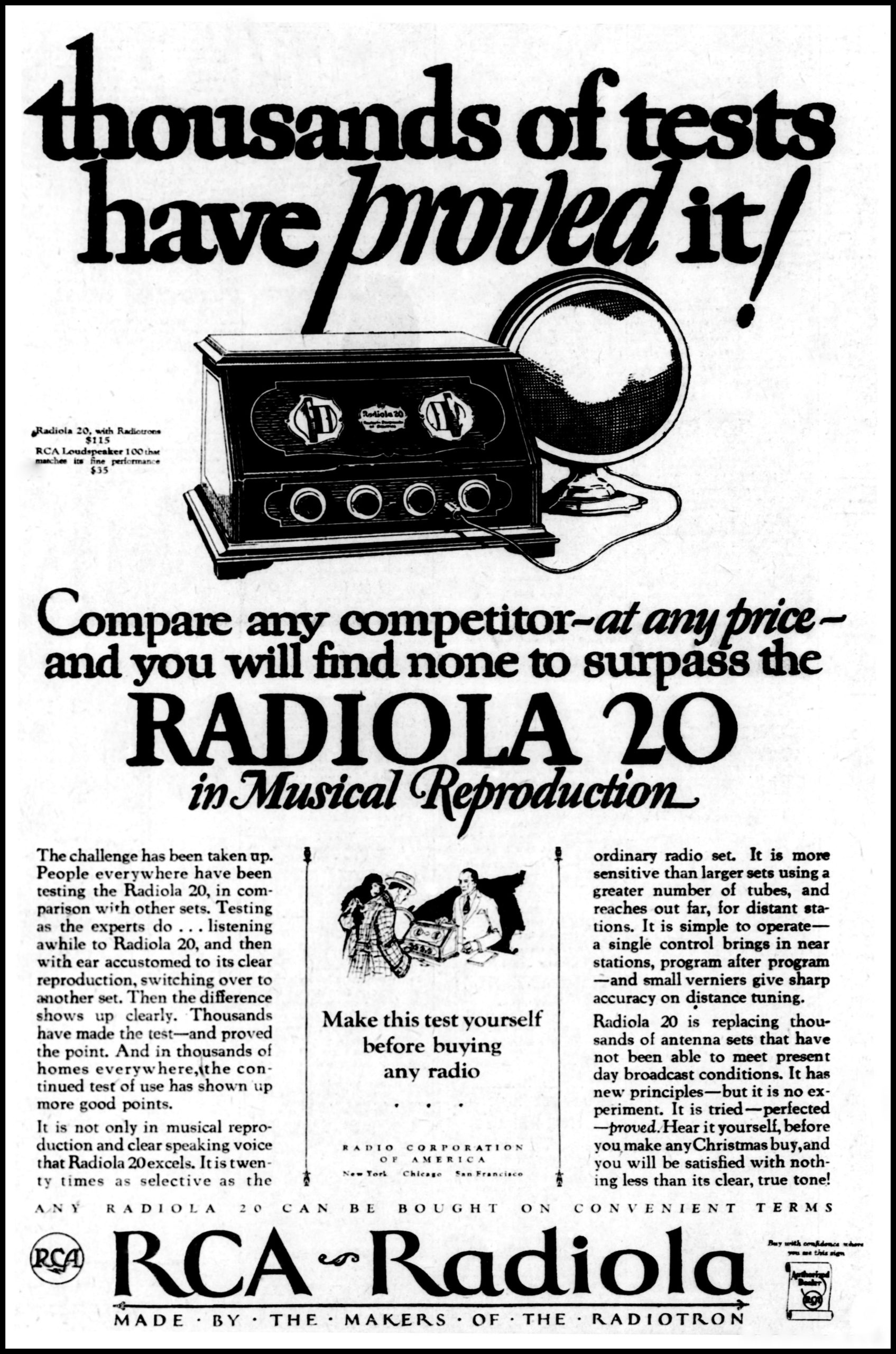 Primary Source: Print Advertisement
Primary Source: Print Advertisement
A 1920s magazine ad for a new RCA radio set. Since receiving radio signals was free, the only cost was the purchase of the radio itself.
Syndicated radio programs like Amos ‘n’ Andy, which began in the late 1920s, entertained listeners around the country. In the case of the popular Amos ‘n’ Andy, it did so with racial stereotypes about African Americans familiar from minstrel shows of the previous century. No longer were small corners of the country separated by their access to information. With the radio, Americans from coast to coast could listen to the same programming. This had the effect of smoothing out regional differences in dialect, language, music, and even consumer taste.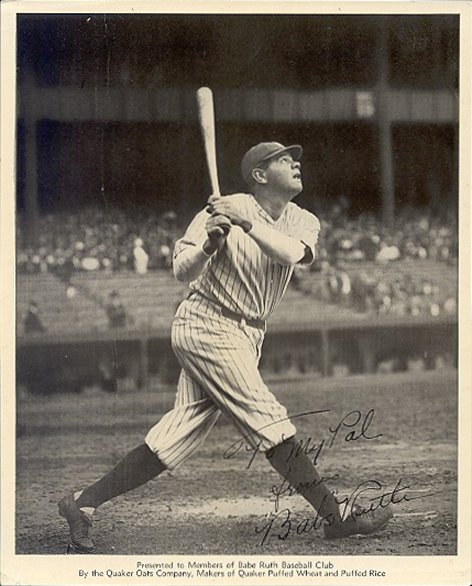 Primary Source: Photograph
Primary Source: Photograph
Babe Ruth was the great baseball hero of the 1920s and 1930s. He played first for the Boston Red Sox and later for the New York Yankees.
Radio also changed how Americans enjoyed sports. Announcers started sharing live play-by-play of games over the radio and millions of people could now share in the games as they happened. Radio helped to make new sports heroes. Jim Thorpe was known as one of the best athletes in the world. He won medals at the 1912 Olympic Games, played Major League Baseball, and was one of the first members of the National Football League. Other sports stars also became famous. In 1926, Gertrude Ederle became the first woman to swim the English Channel. Helen Wills was a great women’s tennis player, winning Wimbledon eight times in the 1920s, and “Big Bill” Tilden won the national title every year from 1920 to 1925. In football, Harold “Red” Grange played for the University of Illinois. The biggest star of all was the “Sultan of Swat,” Babe Ruth, who became America’s first baseball hero. He changed the game of baseball. Before Babe Ruth, most games had low scores. But Babe Ruth hit so many home runs that baseball became much more fun to watch. In 1924, he hit 60 home runs.
The radio made the first national fads. Without a way to share live events, fads were only shared with people who lived in one small area. There were many kinds of fads in the 1920s. One of the most popular was the dance marathon. In a normal dance marathon, people would dance for 45 minutes and rest for 15. The longest marathons lasted 36 hours or more. Beauty pageants also became popular. The first Miss America Pageant was held in Atlantic City in 1921. One of the most strange fads was flagpole sitting. The goal was simple: be the person who could sit on top of a flagpole for the longest time. Fifteen-year-old Avon Foreman sat on a flagpole for 10 days, 10 hours, 10 minutes, and 10 seconds.
THE BIRTH OF HOLLYWOOD
Because many Americans had more money in the 1920s, they could use some of their money to pay for entertainment. As movies became more popular, movie theaters opened in major cities. A ticket for two movies and a live show cost twenty-five cents. In a time before television, people of all ages went to the movies more often than today, sometimes more than once each week.
The silent movies of the early 1920s created the first generation of movie stars. Rudolph Valentino and Clara Bow were two of the first movie stars. However, no star was more famous than Charlie Chaplin. This tramp with sad eyes, a mustache, big pants, and a cane was the top star of his time.
In 1927, the world of the silent movie ended when the first talkie, The Jazz Singer came out. This movie, which starred Al Jolson, told a very American story of the 1920s. It follows the life of a Jewish man as he became a famous jazz singer. Both the story and the new sound technology used to present it were popular with people around the country. It quickly became a huge hit for Warner Brothers, one of the big five motion picture studios in Hollywood along with Twentieth Century Fox, RKO Pictures, Paramount Pictures, and Metro-Goldwyn-Mayer (MGM).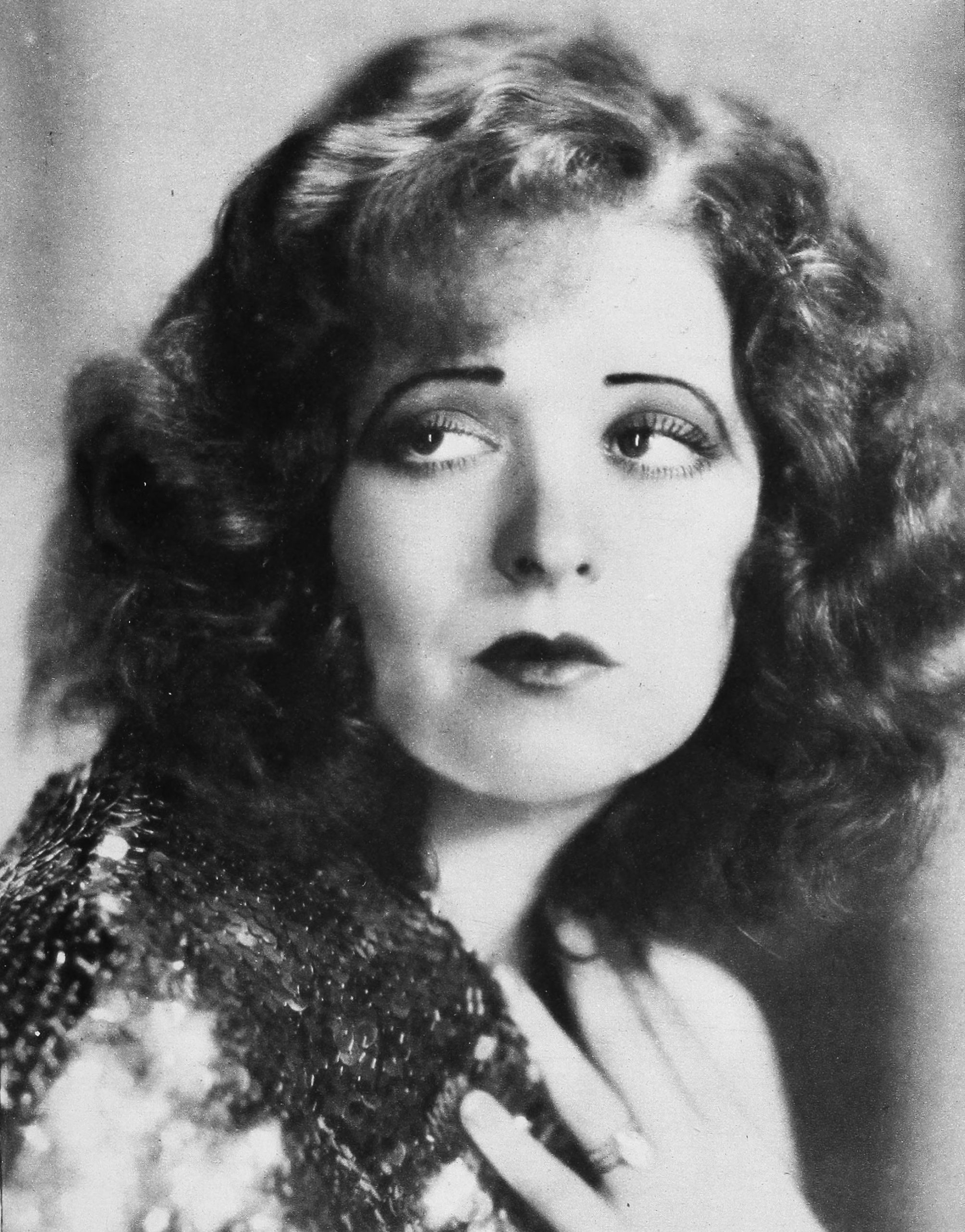
Primary Source: Photograph
Clara Bow was the greatest female movie star of the silent era. Her “look” was copied by girls across America, especially her sad eyes.
Southern California in the 1920s, had only recently become the center of the American film industry. Film making was first based in and around New York, where Thomas Edison first showed the kinetoscope in 1893. When D. W. Griffith filmed In Old California (1910), the first movie ever shot in Hollywood, California, the small town north of Los Angeles was little more than a village. As movie makers moved to southern California, Hollywood grew. California offered sunshine, and many natural film sets. The ocean, a desert, mountains, palm trees, and forests were all easy to get to from Hollywood. By the 1920s, the once-small village was home to a great industry.
Animators also found the 1920s a good time. Short, animated films were popular in movie theaters during this time. The late 1920s saw the start of Walt Disney and his studio. Mickey Mouse made his start in “Steamboat Willie” on November 18, 1928. Mickey would go on to star in more than 120 cartoons. This jump-started Walt Disney Studios and led him to draw many other characters in the 1930s. In 1937, Disney released Snow White and the Seven Dwarfs, the first long animated movie.
JAZZ
One of America’s great gifts to the world of music was jazz, which started in the late 1800s and early 1900s as African Americans mixed old European music with African and slave songs. Although jazz grew over time, it became popular in the 1920s.
Jazz comes in many forms, but it is known for swing and blue notes, call and answer, different rhythms and improvisation. The style of music that came before jazz was ragtime, with musicians like Scott Joplin turning out songs for piano that many people liked at the turn of the century. Jazz first appeared in New Orleans in the early 1900s. Then, after World War I, large numbers of jazz musicians moved from New Orleans to big northern cities such as Chicago and New York, and jazz was heard by more people. Different styles of jazz developed in different cities. Because people listened to jazz in nightclubs where alcohol was sold during Prohibition, and because people could listen to jazz on records and the radio, jazz became very popular in a short time. New jazz stars included Duke Ellington, Cab Calloway, and Chick Webb. Places to listen to jazz like the Apollo Theater and the Cotton Club became symbols of the 1920s, and the name the Jazz Age is used to talk about the 1920s.
Dances such as the Charleston, developed by African Americans, became popular among different people, including among young Whites in the cities. With the start of radio broadcasts in 1922, Americans were able to experience different kinds of music without going to jazz clubs in the cities. Sadly, because of racial prejudice, most radio stations played songs by White jazz artists more than Black artists such as Louis Armstrong, or Jelly Roll Morton.
Several famous female musicians also became popular during the 1920s, including Bessie Smith who was a great singer and a Black woman. It was not until the 1930s and 1940s, however, that female jazz and blues singers such as Smith, Ella Fitzgerald, and Billie Holiday were respected in the music industry.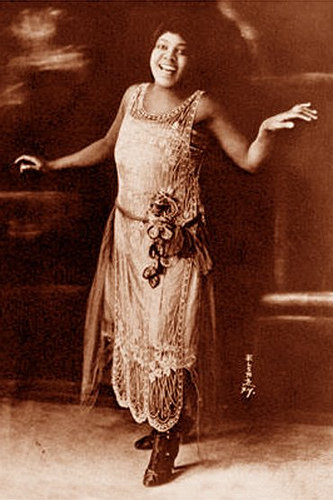 Primary Source: Photograph
Primary Source: Photograph
Bessie Smith was one of the great singers of the early years of jazz.
FLAPPERS
After 1920, the fight for women’s right to vote was finally over. It took 72-years for women to finally be able to vote. People like Carrie Chapman Catt and Alice Paul had given up so much to win voting rights. To their surprise, young women in the Jazz Age seemed like they did not care about these things. During the 1920s, many young women of the age wanted to have fun and so were born the flappers.
Flappers were single, young, middle-class women. They were from the north and lived in the cities. The Gilded Age gave women many new jobs to choose from. There were jobs working in offices, and an increase of phone usage needed people as operators to connect all the calls being placed. With more people making, selling, and buying things in the 1920s, there were also more jobs for young women in department stores. Those jobs needed women to interact with other customers — other women. But the flapper was not all work and no play.
By night, flappers liked to go out. They went to jazz clubs and vaudeville shows. Speakeasies were places flappers liked to go as the new woman of the 1920s showed that they cared as much about prohibition as men. More young women drank alcohol after it was illegal than ever before. Smoking, something else that only men did, became popular among flappers. Women also wanted to end social double standards. The flappers were less shy about sex than women in the past. Psychologist Sigmund Freud had just written about how enjoying sex was normal, and flappers felt more free to explore.
The flappers did not like the style of their mothers who had dressed in the Gibson Girl look. The Gibson Girl was a style that was famous because of drawings by Charles Dana Gibson. His picture of the perfect woman had an hourglass shape, held in tight with a corset, and wore a dress with a high neck, full-length arms, and a long dress all the way down to the floor. The Gibson Girl’s hair was pinned up. The flapper said “no” to everything about the Gibson Girl’s look. Young women cut their hair to shoulder length. Dresses only went to the knee. Make-up companies grew as women used make-up in large numbers. Flappers wore high heeled shoes, left corsets behind and wore clothes with straight lines instead of curves.
Many women loved the age of the flapper. They tried out new looks, jobs, and ways of living that set them free from the old rules of the Victorian Age of the 1800s. The flappers made choices that they wanted to and did not listen to their fathers or husbands. But flappers were not all good. The political wins like the right to vote were not interesting to the flappers, and women did not work on winning new rights until the 1960s.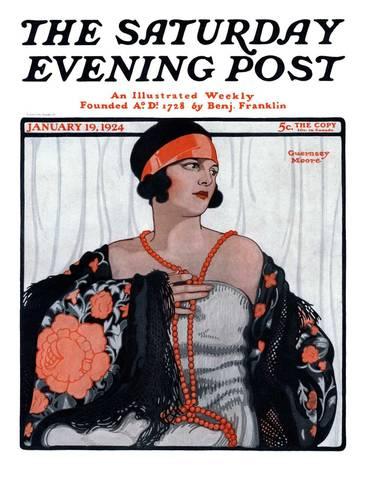 Primary Source: Magazine Cover
Primary Source: Magazine Cover
In 1924, The Saturday Evening Post marked the birth of the new fashion ideas of the 1920s with a drawing of a flapper on its cover.
TEENAGERS
In the 1800s, the American world was made up of children and adults. Most Americans tried their best to let their children enjoy their youth while slowly preparing to be adults. Some children still had to work, but many states passed laws that stopped children from working. The average number of years spent in school for young Americans went up. Parents waited longer before they told their children to get married. It was clear that a new time in life had arrived – being a teenager. American teens were different from children and adults, and being a teenager was something that started in the 1920s.
The car was the single greatest thing that made teenagers free from their families. In earlier times, young boys and girls spent their first dates at home where the boy would meet the girl’s parents. They would sit in the house, followed by dinner with the whole family. Later at night, the couple might enjoy a few minutes alone outside. After a few times together, they could get lucky and be able to walk alone through town. The car changed the old ways. Parents did not watch over their children any more. Ideas about privacy, and sex changed all over America. Also, because of the car, teens were able to date people from outside their small towns.
Cars also helped lead another new idea: the consolidated high school where many teenagers from all over studied together . Buses were able to take students far from their homes. Also, Americans knew that learning more was important and students started going to school for more years than in the past. Before long, schools created new things that were different from things for children and adults, such as school athletics and extracurricular activities.
ART
The 1920s was a time of new ideas in art and architecture.
Art Deco was a popular style in art and architecture of the 1920s. Starting in Europe, it spread throughout Western Europe and North America in the mid-1920s and was popular through the 1930s and early 1940s. The name is short for Arts Décoratifs, which came from a French architect named “Le Corbusier.“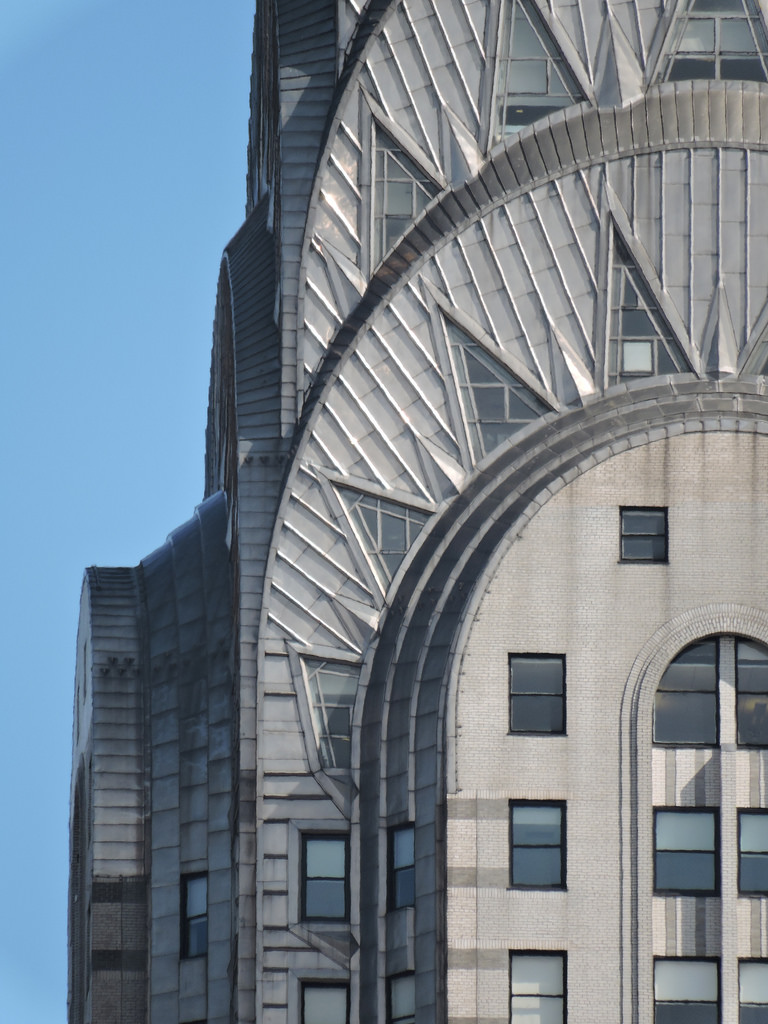 Primary Source: Photograph
Primary Source: Photograph
A close-up photograph of the top of the Chrysler Building in New York City shows some of the Art Deco parts of the design, especially shapes that repeat.
The new style was born between World War I and World War II, a time called the interwar period. It put together old styles with new styles that were inspired by machines. Art Deco used rich colors, details and geometric shapes. New York City’s Chrysler Building and the Empire State Building are examples of the Art Deco style from that time. Other American examples can be found in Chicago, Los Angeles, and San Francisco. The Hoover Dam, built between 1931 and 1936 on the border between Nevada and Arizona, includes Art Deco art throughout the dam. Art Deco was not used only in buildings. Artists used Art Deco in ads, posters and other arts also.
Surrealism was another new idea that began in the early 1920s. Surrealist works had things that were strange, out of place, or put together things that did not match. Spanish painter Salvador Dali, best known for his 1931 work, The Persistence of Memory, was one of the most famous artists who used Surrealism.
As with many other areas of life, Americans were excited about trying new things, and new ways of seeing the world through art were just another way of having a good time.
CONCLUSION
Work and school make things possible. They are how we get money to feed our families and we need to go to school to find good jobs. However, they are not usually the things we look forward to most in life. When we look back at the things that we were most excited about, or look back through the photos in our phones, our favorite memories are friends, eating, parties, events, shopping and trips. Think about how much time we spend watching videos. Would those hours be better spent studying?
Maybe so, or maybe not. Maybe being connected to the people around us is what makes our life happy. Maybe popular culture is not a waste of time at all. Maybe it is what makes work and school worthwhile.
What do you think? Is pop culture a distraction?
CONTINUE READING

SUMMARY
BIG IDEA: Radio, phonographs and movies made it possible for everyone in America to share the same ideas for the first time.
During the 1920s, as more and more Americans had electricity in their homes and could afford radio sets, radio became an important form of entertainment. For the first time, Americans could all listen to the same radio shows, or listen to live sports broadcasts.
Baseball, football, swimming, tennis, and boxing were popular sports.
Fads such as flagpole sitting, dance marathons, and beauty pageants became popular across the nation.
Hollywood and the movie industry were born in the 1920s. The first movies had no sound, but eventually “talkies” were invented. Just like today, movie stars were fashion idols. The first cartoons also were born in the 1920s, including Walt Disney’s Mickey Mouse.
Jazz was a new American form of music that became popular in the 1920s. Based on old African-American musical traditions, Jazz became popular in the North and among White audiences.
Some middle-class and upper-class young women rejected traditional gender roles and the fashion sense of their mothers and embraced a new style. These flappers went out without chaperones, smoked, drank, danced, and dressed in shocking new ways (at least shocking for the 1920s).
The idea of the teenager was born in the 1920s. High schools added sports, extracurricular activities, and many young Americans waited longer to get married or start working.
New forms of art became popular in the 1920s. Art deco used bold colors, repeated patterns, and geometric shapes. Both artists and architects used this new style. Alternatively, some artists embraced surrealism, which included the painting of fantastic, dream-like images.

VOCABULARY
![]()
PEOPLE AND GROUPS
Guglielmo Marconi: Italian inventor who pioneered radio.
Jim Thorpe: Native American who studied at the Carlisle Indian School, played in the Olympics, and played professional baseball and football.
Gertrude Ederle: First woman to swim the English Channel.
Helen Wills: Women’s tennis champion in the 1920s.
“Big Bill” Tilden: Men’s tennis champion in the 1920s.
Harold “Red” Grange: Star football player in the 1920s.
Rudolph Valentino: Famous movie start of the 1920s. He was known for his sex-appeal.
Babe Ruth: Famous homerun-hitting baseball player of the 1920s and 1930s. He played for the New York Yankee’s and inspired nicknames such as the “Sultan of Swat.”
Clara Bow: Most famous film actress of the silent film era.
Charlie Chaplin: Famous actor, writer, and director of the early film era. He is most famous for playing the tramp.
D. W. Griffith: Director who filmed the first movie in Hollywood.
Walt Disney: Animator who created the first animated films. His character Mikey Mouse debuted in 1928.
Duke Ellington: Early jazz musician who led an orchestra.
Louis Armstrong: Famous jazz musician. He sang and played the trumpet.
Jelly Roll Morton: Pianist and bandleader from New Orleans who claimed to have invented jazz.
Bessie Smith: Great female jazz and blues singers of the 1920s.
Ella Fitzgerald: Great female jazz singer beginning in the 1930s. She was sometimes called the Queen of Jazz.
Billie Holiday: Along with Ella Fitzgerald, one of the great female jazz singers of the 1930s, 1940s and 1950s.
Flappers: Northern, urban, single, young middle-class White women who rejected social expectations, wore makeup, dated, smoked, drank, danced, and dressed in dresses that were short, sleeveless and straight. They are emblematic of the 1920s.
Sigmund Freud: Scientist who popularized psychology. His ideas about sex were shocking but captivated American’s attention.
Gibson Girl: Fashion style popular at the turn of the century that feature long dresses that covered necks, arms and legs. Underneath was a corset, and hair would be tied up, often with a hat. The Flappers of the 1920s rejected this style.
Le Corbusier: French architect who popularized Art Deco style.
Salvador Dali: Spanish artist. He is the most famous artists of the surrealist style.
![]()
KEY IDEAS
Dance Marathon: Dance Marathon: A competition popular in the 1920s in which couples tried to see who could dance for the longest amount of time.
Miss America Pageant: Beauty contest established in the 1920s.
Flagpole Sitting: Fad in the 1920s in which people stat on chairs at the top of flag poles.
Consolidated High School: A form of high school established in the 1920s that was larger because busses carried students in from many neighborhoods.
School Athletics: Sports played by high school students. It was a creation of the 1920s.
Extracurricular Activities: Student clubs, dances, etc. that became a part of school life in the 1920s.
![]()
DOCUMENTS
Hollywood: Neighborhood of Los Angeles that became the center of the new movie industry in the 1920s.
Apollo Theater: Theater in New York that hosted many early jazz musicians.
Cotton Club: Club in New York that hosted many early jazz musicians.
Chrysler Building: Skyscraper in New York City built in the 1920s in the art deco style. It was briefly the tallest building in the world until the Empire State Building a few blocks away was completed.
Empire State Building: Iconic building in New York City. Completed in 1931, it is an excellent example of the art deco style of its time.
![]()
BUSINESSES
Radio Corporation of America (RCA): Early company that sold radio sets to everyday Americans.
National Broadcasting Company (NBC): First broadcasting company in America. It was founded by RCA to produce content for the radios RCA was selling.

TECHNOLOGY
Silent Movies: The first form of movies that did not have sound. They were accompanied by live musicians playing music in the theater.
Talkie: Nickname for the first movies with sound.

THE ARTS
The Jazz Singer: The first film with sound. It started Al Jolson.
Steamboat Willie: The first animated film featuring Mickey Mouse.
Jazz: Musical style created around 1900. It grew out of West African influences, ragtime, slave songs, and European classical influences. First created in New Orleans, it was popularized in the rest of the country during the 1920s. It often features syncopated rhythms and improvisation.
Charleston: Dance craze that swept the nation in the 1920s.
Art Deco: Artistic style popularized in the 1920s and 1930s featuring geometric shapes, repletion, and solid colors.
Surrealism: Art style popular in the 1920s. It features dreamlike images rather than realistic representations. The most famous painter of this style was Salvador Dali.
